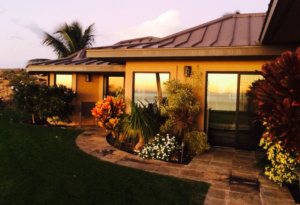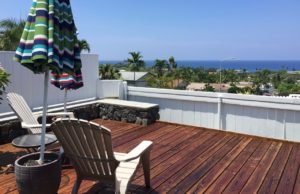 Buying a home in Hawaii from the mainland is a dream come true for most people. Thoughts of living in a warm climate year round, with the smell of tropical flowers and the ocean in the air at all times. Those things exist here, yes, but there are a few aspects of buying a home on the Big Island that you should be aware of:
Buying a home in Hawaii from the mainland is a dream come true for most people. Thoughts of living in a warm climate year round, with the smell of tropical flowers and the ocean in the air at all times. Those things exist here, yes, but there are a few aspects of buying a home on the Big Island that you should be aware of:
- Fee simple vs leasehold
- Lava Zones
- Mortgage Funding from Local vs Mainland banks
- Elevation and How It Affects Comfort and Energy Costs
- Square Footage Expectations
1. Fee Simple Vs Leasehold Real Estate
FEE SIMPLE: If you have purchased a home on the mainland, most likely you have purchased a fee simple property. ee simple ownership is probably the most familiar form of ownership to buyers of residential real estate. Fee simple is the most complete form of ownership. A fee simple buyer is given title (ownership) of the property, which includes the land and any improvements to the land in perpetuity. The fee simple owner has the right to possess, use the land and dispose of the land as he wishes–sell it, give it away, trade it for other things, lease it to others, or pass it to others upon death.
LEASEHOLD: In Hawaii, especially on the Big Island, much of the land is owned by the State of Hawaii or the Federal government (Volcanoes National Park), but the third largest landholder is Kamehameha Schools. They lease out much of the farmland and large land parcels, creating a leasehold arrangement to live on that land. First, the buyer of leasehold real estate does not own the land; they only have a right to use the land for a pre-determined amount of time. Second, if leasehold real estate is transferred to a new owner, use of the land is limited to the remaining years covered by the original lease. At the end of the pre-determined period, the land reverts back to the Lessor, and is called reversion. Depending on the provisions of any surrender clause in the lease, the buildings and other improvements on the land may also revert to the lessor. So, when you see REALLY inexpensive homes or condos on the island, those may be on land that has an expiring lease, and will have to be renegotiated with the lessee.
2. Lava Zones
Hazard zones from lava flows are based chiefly on the location and frequency of both historic and prehistoric eruptions. Since Kilauea is continuing to erupt and has threatened the town of Puna and East Hawaii, that is an active lava zone, and finding funding may be more difficult. If you are searching online for a home, make sure you are also checking out the lava zones for the areas you are looking at. Good news? West Hawaii and Kailua Kona are in Lava Zone 4, which has not experienced an eruption in quite some time. And if you are really worried? Check out Hawi in Zone 9, where the last time there was an eruption was 60,000 years ago!
3. Using a “Local” Bank vs a Mainland Bank for Your Mortgage
Hawaii is a “Good Funds” state, meaning that the money has to be in the title company’s hands before the transaction is complete. (Read more here) Mainland banks sometimes do not wire funds until the date of closing, and cause the transaction to become delayed, as title companies in Hawaii have to wait up to five days to accept those funds from mainland banks. On the Big Island, you will not find a Bank of America or Wells Fargo. Before getting a mortgage, we suggest discussing your financing options with a local Realtor.
4. How Elevation Affects Energy Costs and Comfort
 When you come and visit Hawaii, you may stay in a hotel with air conditioning, or in a beach condo with open air floor plans to catch the tropical air flow as it goes mauka to makai (land to sea) and back again in the evening. When you are considering purchasing a home, air flow and elevation are key to long term comfort and energy cost control. Unlike the hotels, where air conditioning is second nature to visitors, many homes in Hawaii do not have force air ventilation due to the high energy costs of running A/C. WIth energy costs being the highest in the nation, finding a natural cooling process is best. You will find that homes located in the 700-1500 elevation on the island may be a bit more expensive, because the temperatures can be up to 10 degrees cooler than down by the ocean. This can save you hundreds of dollars in fan and air conditioning energy costs. As a rule of thumb, every 200 feet in elevation can equate to 1 degree cooler in temperature.
When you come and visit Hawaii, you may stay in a hotel with air conditioning, or in a beach condo with open air floor plans to catch the tropical air flow as it goes mauka to makai (land to sea) and back again in the evening. When you are considering purchasing a home, air flow and elevation are key to long term comfort and energy cost control. Unlike the hotels, where air conditioning is second nature to visitors, many homes in Hawaii do not have force air ventilation due to the high energy costs of running A/C. WIth energy costs being the highest in the nation, finding a natural cooling process is best. You will find that homes located in the 700-1500 elevation on the island may be a bit more expensive, because the temperatures can be up to 10 degrees cooler than down by the ocean. This can save you hundreds of dollars in fan and air conditioning energy costs. As a rule of thumb, every 200 feet in elevation can equate to 1 degree cooler in temperature.
5. Square Footage Expectations
 One factor that has been popping up in calls to the LUVA Real Estate office lately has been mainland buyers looking for a home with alot of square footage “under roof”. “So many mainland buyers come in and forget our living in Hawaii is outdoors,” states LUVA Realtor, Lance Owens. “I get calls from a lot of mainland people who are “downsizing” to a 2,500 square foot house and realize there are not many homes that large in West Hawaii and in the price point they are searching at”, Owens stated. When you hear the real estate phrase in Hawaii, “Bringing the outside in”, which means that in Hawaii, much of life is spent outdoors. Because indoor spaces are expensive and difficult to keep cool, residents love being out on their lanai’s (outdoor decks). When searching for a home, don’t rely on just square footage of the home. Take a look at the photos and see how much outdoor space is available, as well. Some homes have more outside dining, entertaining and recreation space than indoor. And why not? You want to move to Hawaii, right? Outdoor living is what it’s all about!
One factor that has been popping up in calls to the LUVA Real Estate office lately has been mainland buyers looking for a home with alot of square footage “under roof”. “So many mainland buyers come in and forget our living in Hawaii is outdoors,” states LUVA Realtor, Lance Owens. “I get calls from a lot of mainland people who are “downsizing” to a 2,500 square foot house and realize there are not many homes that large in West Hawaii and in the price point they are searching at”, Owens stated. When you hear the real estate phrase in Hawaii, “Bringing the outside in”, which means that in Hawaii, much of life is spent outdoors. Because indoor spaces are expensive and difficult to keep cool, residents love being out on their lanai’s (outdoor decks). When searching for a home, don’t rely on just square footage of the home. Take a look at the photos and see how much outdoor space is available, as well. Some homes have more outside dining, entertaining and recreation space than indoor. And why not? You want to move to Hawaii, right? Outdoor living is what it’s all about!
Feel free to contact us LUVA Real Estate for more information about buying a home in Hawaii and let us answer any questions you may have!